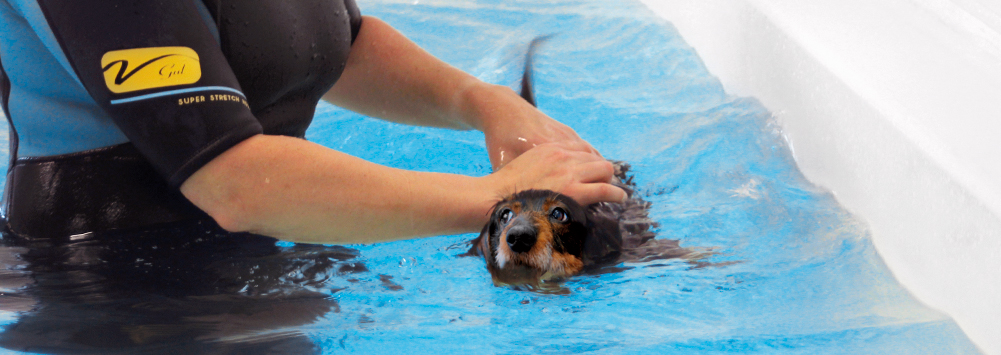Our hydrotherapy facilities feature a purpose built wet room with an aquatic treadmill and a hydro pool. The water is maintained at a therapeutically warm temperature, with chlorine and pH levels closely regulated.
The buoyancy of the water in both the pool and the treadmill, helps to support bodyweight, providing a low impact and controlled way of exercising.
Following surgery, the careful use of hydrotherapy can help with rehabilitation and increases chances of returning to full fitness. Common cases involve post spinal or orthopedic surgery, including cruciate and patella surgery, hip replacement and limb amputation. As long as the referring vet agrees, hydrotherapy can commence once the surgical site has healed and any sutures have been removed.
Hydrotherapy can enhance general health and fitness, aiding convalescence and weight loss and improving recovery rates. The preferred therapy for weight loss is hydrotherapy. In order to monitor progress, we use our onsite facilities to weigh and record patients’ weight. Our team are able to provide a structured weight loss programme, with regular hydrotherapy sessions as part of an ongoing rehabilitation programme. All therapy plans are tailored to each individual case, with osteoarthritis patients often prescribed long term therapy as part of a maintenance programme.
Hydrotherapy is predominantly used with dogs, although some cats do cope well with this form of treatment. Physiotherapy techniques are accepted by the majority of dogs and cats and can also be adapted to help a variety of other species.

During a hydrotherapy session:
- The patient is given time to meet the therapist and acclimatise to the environment
- The patient is fitted with a specialist harness and collar
- Shower work is carried out prior to a hydrotherapy session, for hygiene purposes. Therapeutic handling is used to improve posture and prepare muscles for exercise
- The hydrotherapist will gently encourage and assist the patient into the pool or treadmill, via the entry ramp. For large breed patients requiring additional assistance, two people will be present in the pool
- In addition to swimming, the session may include some static physiotherapy techniques in the water. For example, passive range of movement, positioning and gait patterning, to encourage correct balance and movement patterns.
- Owners are not required to get into the pool but it can be helpful for them to be present, to encourage the patient and to be involved with the treatment process.
- Session times vary with the individual patient’s needs, but the average session lasts approximately 45 minutes, including preparation and aftercare
- Patients are showered before and after swimming and are towelled and/or blow-dried
- If your pet is particularly nervous, it may take more than one session to carefully introduce them to hydrotherapy, in order for them to slowly gain confidence
- In the unlikely event that your pet does not accept hydrotherapy treatment, there are a variety of land based physiotherapy techniques that can be introduced, as an alternative treatment option.
Hydrotherapy or physiotherapy or both?
In most cases, patients will benefit from a combined course of hydrotherapy and physiotherapy but some cases may require just one or the other. Our therapist will discuss the requirements of the patient in question and assess their specific needs, in order to provide the most effective therapy programme available.
Insurance
Hydrotherapy and/or physiotherapy is often covered by insurance companies but we advise that you check with your individual insurance company prior to commencing treatment.
